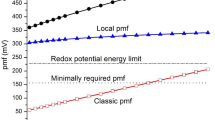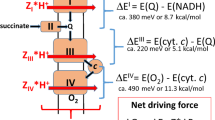Abstract
FOLLOWING recent publications in Nature on hydrogen ion concentrations and flows in mitochondria1–5, Baum6 (see preceding communication) has aptly drawn attention to the fact that the chemiosmotic hypothesis does not require a significant pH. difference across the mitochondrial membrane system7. In the original outline of the hypothesis8 it was shown that the major component of the protonmotive force (p.m.f.) should be a membrane potential. Admitting therefore that the experimental facts may be consistent with the driving of adenosine triphosphate (ATP) synthesis by a proton current that flows through the reversible ATPase system in the cristae membrane under a mainly electrical p.m.f., Baum6 has asked how the very small number of free protons in the inner aqueous phase of a mitochondrion or sub-mitochondrial particle can permit the flow of an effective proton current, and whether there may not be special energetic obstacles to proton translocation in such small systems.
This is a preview of subscription content, access via your institution
Access options
Subscribe to this journal
Receive 51 print issues and online access
$199.00 per year
only $3.90 per issue
Buy this article
- Purchase on Springer Link
- Instant access to full article PDF
Prices may be subject to local taxes which are calculated during checkout
Similar content being viewed by others
References
Chance, B., and Mela, L., Nature, 212, 369 and 372 (1966).
McCabe, M., Nature, 213, 280 (1967).
Chance, B., Nature, 214, 399 (1967).
Mitchell, P., Nature, 214, 400 (1967).
Addanki, S., Cahill, F. D., and Sotos, J. F., Nature, 214, 400 (1967).
Baum, H., Nature, 214, 1326 (1967).
Mitchell, P., Biol. Rev., 41, 445 (1966); Chemiosmtic Coupling in Oxidative and Photosynthetic Phosphorylation (Glynn Research, Bodmin, 1966).
Mitchell, P., Nature, 191, 144 (1961).
Mitchell, P., and Moyle, J., Biochem. J. (in the press).
Mitchell, P., Fed. Proc. (in the press).
Mitchell, P., in Regulation of Metabolic Processes in Mitochondria, 65 (Elsevier, Amsterdam, 1966).
Redfearn, E. R., in Biological Structure and Function, 2, 181 (Academic Press, New York, 1960).
Ernster, L., Dallner, G., and Azzone, G. F., J. Biol. Chem., 238, 1124 (1963).
Mitchell, P., and Moyle, J., in Biochemistry of Mitochondria, 53 (Academic Press, London, 1967).
Glasstone, S., An Introduction to Electrochemistry, 340 (Van Nostrand, New York, 1942).
Bell, R. P., The Proton in Chemistry (Methuen, London, 1959).
Edsall, J. T., in Proteins, Amino Acids and Peptides, 467 (Reinhold, New York, 1943).
Mitchell, P., and Moyle, J., Nature, 208, 1205 (1965).
Author information
Authors and Affiliations
Rights and permissions
About this article
Cite this article
MITCHELL, P. Proton Current Flow in Mitochondrial Systems. Nature 214, 1327–1328 (1967). https://doi.org/10.1038/2141327a0
Received:
Issue Date:
DOI: https://doi.org/10.1038/2141327a0
This article is cited by
-
What history tells us XI. The complex history of the chemiosmotic theory
Journal of Biosciences (2007)
-
Human malarial disease: a consequence of inflammatory cytokine release
Malaria Journal (2006)
-
Some physical parameters controlling cell size during the evolution of the procaryons
Origins of Life (1975)
Comments
By submitting a comment you agree to abide by our Terms and Community Guidelines. If you find something abusive or that does not comply with our terms or guidelines please flag it as inappropriate.



